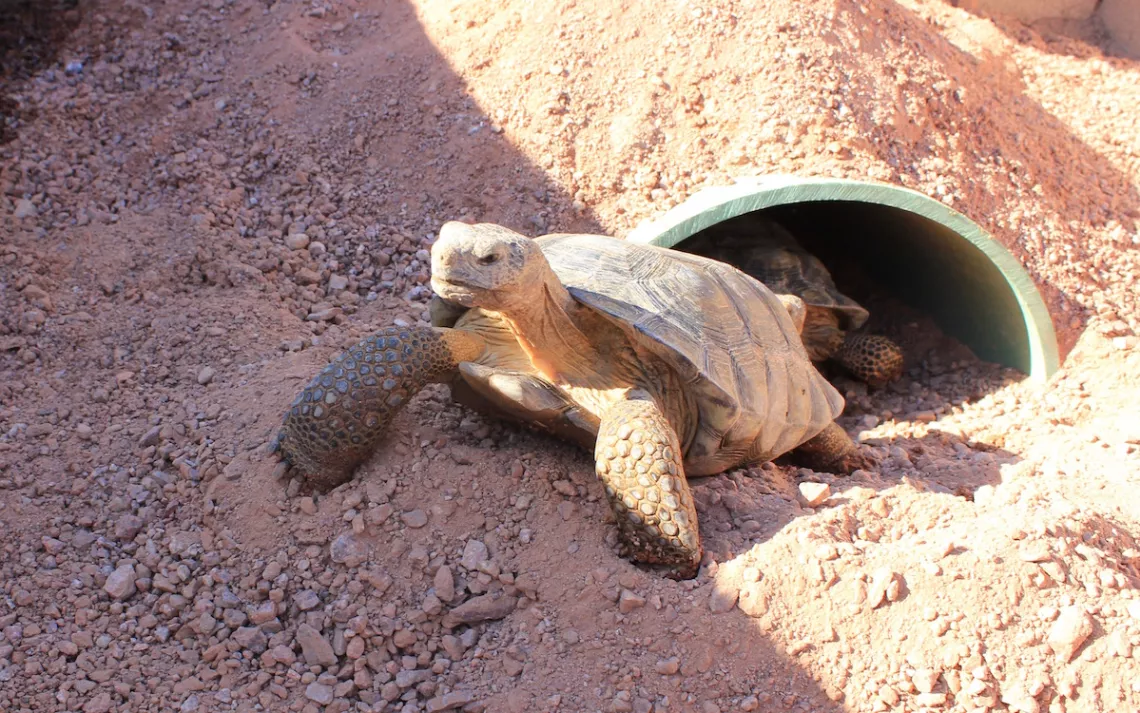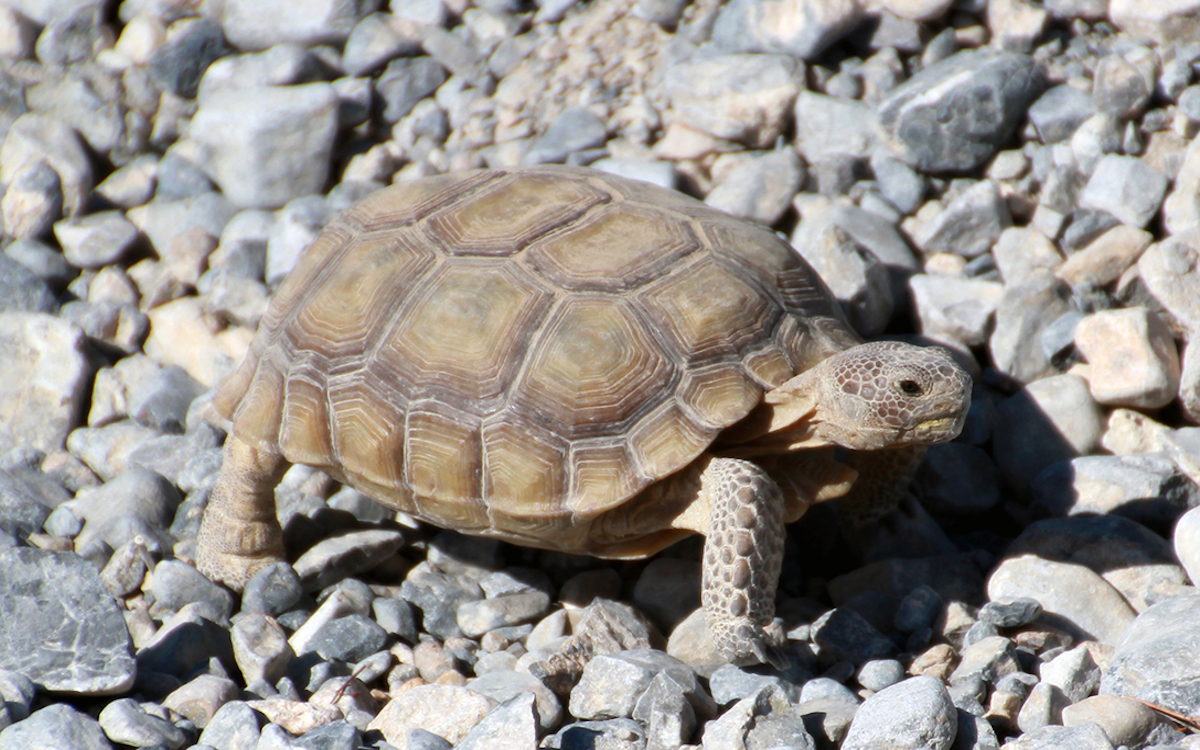Desert Tortoises Gone Captive
Using domesticated tortoises to sustain wild populations is difficult

A desert tortoise leaves its burrow. | Photo courtesy of Daniel Rothberg
In 1922, the biologist Edmund Carroll Jaeger, a careful chronicler of the life of the Mojave Desert, described desert tortoises as “excellent pets.” They have a “certain nobility of form,” he observed in Denizens of the Desert. “Nature has withheld from them the gift of expression,” Jaeger wrote, “but they may speak to us just the same, teaching us simplicity, humility and gentleness.”
Since then, the pet desert tortoise population in the Southwest has grown exponentially. At the same time, the wild desert tortoise population has diminished due to threats such as human development destroying the species’ habitat and diseases such as herpesvirus, shell diseases, and respiratory disease. Biologists and advocacy groups that monitor the species are not exactly sure how many desert tortoises are kept as pets, but researchers and advocates agree that the captive tortoise population could soon surpass the wild tortoise population—if it hasn’t already.
Kobbe Shaw, director of a tortoise-adoption organization in Nevada called Tortoise Group, estimates that there could be as many as 200,000 captive desert tortoises roaming backyards in Las Vegas alone. As implausible as this number might seem—there are about 495,000 single-family homes in the greater Las Vegas area—others don’t think the estimate is too far off.
“Tortoises in backyards have ideal conditions, so they reproduce like crazy,” said C. Richard Tracy, a University of Nevada Reno biologist who researches the Mojave Desert tortoise. “I don’t think 200,000 is an exaggeration, but I don’t know how secure it is as an estimate.”
In addition to backyard breeding, the astronomical figure is due, in part, to the desert tortoise’s long lifespan. In a protected environment, they can live 50 to 80 years.
The surplus of domesticated tortoises would seem to offer a way to assist the wild tortoise population, since the species is listed as “threatened” under the Endangered Species Act. But the Tortoise Group and others say it’s difficult and potentially damaging to use the huge captive population to boost the number of wild tortoises. They instead work to keep the populations separate.
Biologists worry that releasing domesticated tortoises into the wild can spread disease or disrupt the wild gene pool. For the Nevada-based Tortoise Group and similar organizations in Arizona, California, and Utah, the mantra is: “Keep captive tortoises captive. Keep wild tortoises wild.” While researchers have made attempts to integrate domesticated tortoises into wild populations, the efforts usually benefit only small segments of the wild population. Reintroduction to the wild is also costly: captive tortoises must go through exhaustive medical testing before being released into the wild.
“Use of captive animals in a focused recovery effort is probably not going to happen,” said Tom Egan, a former Bureau of Land Management biologist who now works for Defenders of Wildlife.

A wild tortoise near the Desert National Wildlife Refuge north of Las Vegas. | Photo courtesy of Dan Balduini/ U.S. Fish and Wildlife Service
There is a long history of human impacts on the desert tortoise population. Restaurants across the Southwest used to serve tortoises as food. In the 1960s, gas stations on the route from Las Vegas to St. George, Utah gave out free tortoises to customers. Even after federal and state laws were enacted to protect the species, collectors continued taking tortoises from the wild.
Today, wild tortoises face a number of threats. Urban and suburban development, as well as poorly sited renewable energy projects, can shrink their range. Human activities have been known to attract ravens, a top predator, to tortoise habitat areas. This is a hindrance to wild tortoise recovery because ravens often attack younger tortoises with softer shells.
“They are walking ravioli until they get to be about six years of age,” Egan said.
There is no way of knowing exactly how many wild desert tortoises live in the Mojave Desert, but in 2014 the U.S. Fish and Wildlife Service estimated that the population was around 212,000. (Tortoises that live in other areas, such as the Sonoran Desert, were not included).
To experts like Egan, the decrease in the tortoise population has been noticeable. When he worked for the BLM in the 1990s, he would regularly be called upon to pick up tortoises along roads.
“Today you’d be hard-pressed to find animals close to the shoulder of these highways,” Egan said.
Meanwhile, the population of domesticated tortoises continues to grow, creating unique challenges for animal welfare organizations that already struggle to find homes for them.
Tortoises’ renowned longevity creates one tricky issue: pet tortoises can outlive their human companions. “People put their tortoises in their wills,” said Sarah Mortimer at the Tortoise Group, whose tortoise-adoption services include information about how to bequeath a tortoise to someone else should you die before your pet does.
Then there’s the problem of what Mortimer calls “tortoise hoarders.” On a searing Las Vegas afternoon in late June, Mortimer raised the trunk of her silver Jeep Patriot to reveal 11 plastic crates, tortoises tapping at the boxes’ sides. Mortimer had just come from a house call, during which she picked up 20 desert tortoises from one tortoise hoarder.
Four years ago, Nevada wildlife officials made it illegal to keep more than one desert tortoise as a pet, but most caretakers were grandfathered in. With backyard breeding, several desert tortoises can, over a few years, turn into dozens. Hoarders call the Tortoise Group to put their pets up for adoption, and Mortimer has stories about hoarders who have more than 50 tortoises in their yard. “It’s really difficult to tell how many tortoises you even have,” Mortimer said.
Adoption agencies also must deal with domesticated tortoises on the loose. On a near daily basis, Mortimer said the Tortoise Group receives calls about escapees. Tortoises spend part of the year in burrows, so they are good diggers and can tunnel their way out of a yard.
“People find tortoises quite often, especially in residential areas,” she said.
Mortimer unloaded the Jeep and carried the boxes into the Tortoise Group’s habitat, a way station for rescued tortoises waiting to be adopted. Mortimer sprayed the tortoises with a hose; it was 4:50 p.m. and still almost 110 degrees Fahrenheit. She left the tortoises in shaded pens. The tortoises crawled into their burrows and Mortimer filled their water dishes.
Michael Tuma, an ecologist for the U.S. Geologic Service and a leader of the Desert Tortoise Council, keeps pet desert tortoises but also advocates for the recovery of wild tortoises. He is worried about the trend lines—a shrinking wild population and an exploding captive one. “I keep one foot in each arena.…It’s alarming to those of us that are close to it,” he said.
As for how many desert tortoises live as pets, Tuma didn’t have an exact number. “It’s a lot,” he said. “It’s more than you would expect.”
 The Magazine of The Sierra Club
The Magazine of The Sierra Club







